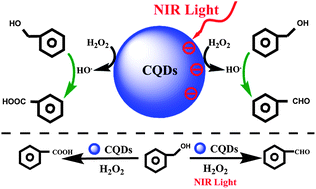Near-infrared light controlled photocatalytic activity of carbon quantum dots for highly selective oxidation reaction†
Abstract
Selective

* Corresponding authors
a
Institute of Functional Nano and Soft Materials (FUNSOM), Jiangsu Key Laboratory for Carbon-Based Functional Materials and Devices, Soochow University, No.199 Ren-ai Road, Suzhou, China
E-mail:
zhkang@suda.edu.cn, yangl@suda.edu.cn
Fax: +86-512-65882846
Tel: +86-512-65880957
b School of Light Industry and Chemical Engineering, Dalian Polytechnic University, Dalian 116034, China
Selective

 Please wait while we load your content...
Something went wrong. Try again?
Please wait while we load your content...
Something went wrong. Try again?
H. Li, R. Liu, S. Lian, Y. Liu, H. Huang and Z. Kang, Nanoscale, 2013, 5, 3289 DOI: 10.1039/C3NR00092C
To request permission to reproduce material from this article, please go to the Copyright Clearance Center request page.
If you are an author contributing to an RSC publication, you do not need to request permission provided correct acknowledgement is given.
If you are the author of this article, you do not need to request permission to reproduce figures and diagrams provided correct acknowledgement is given. If you want to reproduce the whole article in a third-party publication (excluding your thesis/dissertation for which permission is not required) please go to the Copyright Clearance Center request page.
Read more about how to correctly acknowledge RSC content.
 Fetching data from CrossRef.
Fetching data from CrossRef.
This may take some time to load.
Loading related content
